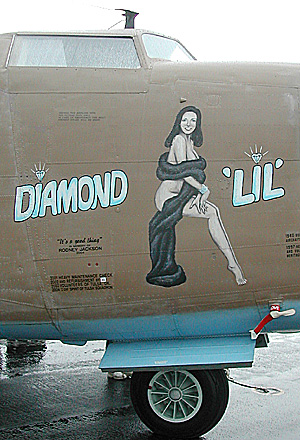
CONSOLIDATED B-24 "LIBERATOR"
Designed in 1938 by Consolidated Aircraft in San Diego, California, to try to improve on the performance of the Boeing B-17, the proposed Model 32 bomber incorporated the new Davis airfoil and the high aspect ratio wing design of their Model 31 experimental flying boat, Fowler wing flaps, the first tricycle landing gear on a heavy bomber, and the twin tails of the Model 31 was actually removed and installed on the prototype for it's first flight.
Close up of the nose art.
Wind tunnel tests confirmed the improved performance of the design and in February, 1939, the U.S. Army Air Corps issued a Type Specification to cover the Consolidated design. After allowing nominal time for other manufacturers to submit designs, a contract to build the XB-24 was signed on March 30, 1939. The USAAC was so confident of the design, seven YB-24 service test airplanes were ordered on April 27, 1939, before the final design of the XB-24 was complete. Additionally, 38 B-24As were ordered in August, 1939, prior to the first flight of the prototype. The XB-24 made its first flight on December 29, 1939, one day under nine months after the contract was signed.
As the war in Europe escalated, France placed an order with Consolidated in May, 1940, for B-24s, but France was overrun by the Axis before they were built and these aircraft were later diverted to Britain as LB-30s.
Britain desperately needed a long range bomber for use in a coastal patrol and defense squadron, and Consolidated received permission to divert 6 of the 7 YB-24 aircraft to Britain as LB-30s with British serial numbers (AM258 to AM263), along with the first 20 (S/N 40-2349 to 40-2368) production aircraft in the USAAC order for 38 B-24As. These 20 aircraft were assigned British serial numbers (AM910 to AM929) and the USAAC serial numbers were reassigned to the first 20 B24D aircraft.
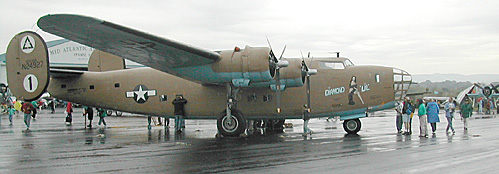 B-24 parked on the tarmac. For $3, you could walk inside, which I did. For $400, you could take a ride, which I didn't.
B-24 parked on the tarmac. For $3, you could walk inside, which I did. For $400, you could take a ride, which I didn't.
Of the remaining 18 B-24A aircraft, 9 aircraft (S/N 40-2369 to 40-2377) were built and delivered to the USAAC as B-24A's. The other 9 aircraft (S/N 40-2378 to 40-2386) were modified on the production line to B24C models by replacing the original Pratt & Whitney R-1830-31 radials with -41 turbo supercharged radials, adding the elliptical engine cowling, installing an A-6 type power turret in the tail with twin 50-cal machine guns, and mounting a Martin power turret on the top forward fuselage. These aircraft were used for testing and training; none were ever flown in combat.
In an effort to increase performance, the remaining YB-24 was retrofitted with R1830-41 turbo supercharged engines, self sealing fuel tanks, and the elliptical engine cowlings that were characteristic of all B-24 models, starting with the -D. The converted aircraft was designated the XB-24B and the improvements were incorporated into the B24D design when the Army exercised a 1939 option and ordered 56 more airplanes. The Commemorative Air Force owns and operates the oldest B-24 type aircraft in existence. It was the 25th of over 18,000 built.
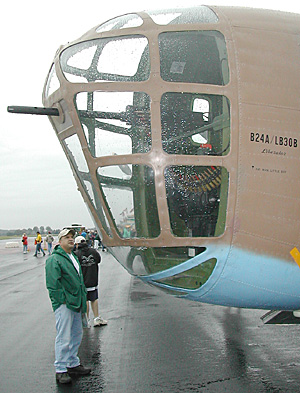 Consolidated Aircraft Corporation, one of the companies merged over the years into what is now General Dynamics Corporation, produced the first B-24 Liberator bombers for the Royal Air Force of Great Britain. Early production models of the B-24 were delivered to the British with the first six off the line known as LB-30As. This aircraft, the 18th LB-30 of an order of 20 for Great Britain, was involved in an accident on its delivery flight to Canada in 1941. Consolidated rebuilt it to a transport configuration and it was used as a company aircraft throughout World War II.
Consolidated Aircraft Corporation, one of the companies merged over the years into what is now General Dynamics Corporation, produced the first B-24 Liberator bombers for the Royal Air Force of Great Britain. Early production models of the B-24 were delivered to the British with the first six off the line known as LB-30As. This aircraft, the 18th LB-30 of an order of 20 for Great Britain, was involved in an accident on its delivery flight to Canada in 1941. Consolidated rebuilt it to a transport configuration and it was used as a company aircraft throughout World War II.
MG Station from side.
It flew on a scheduled basis between San Diego, Fort Worth, and New York. From its Consolidated serial #AM-927, the plane became known along this route as "Old 927."
After the war, "Old 927" was sold to the Contintental Can Company, and flown as an executive transport for about 10 years. Then it was sold to Mexico's national oil company, Petroleos Mexicanos (PEMEX), and flown in Latin America until the CAF acquired it in 1967.
Since her Ghost Squadron debut in 1967, "Old 927" has performed majestically before crowds of thousands of people. In 1971, she was put in the paint scheme and markings of the 98th Bomb Group of the 9th Air Force.
Cockpit of the B-24.
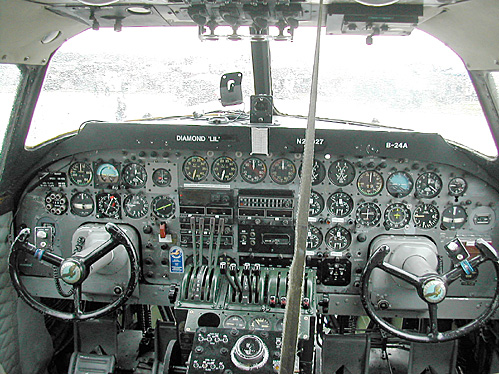
Bomb bay of the B-24.

MG Station from front.
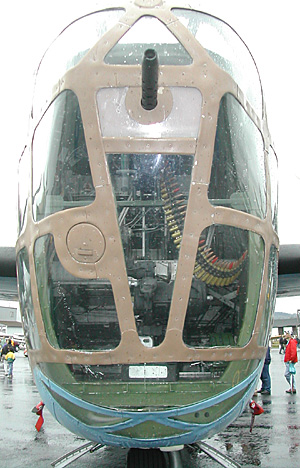
WWII Weekend
IntroductionAircraft
Ground
- Grossdeutschland Division (Re-enactors)
American Europe Encampment (Re-enactors)
WWII Re-enactment: US vs. Germans
British Encampment (Re-enactors)
German Afrika Korps Encampment (Re-enactors)
American Pacific Encampment (Re-enactors)
Back to List of Historic Sites
Back to Travel Master List
Back to MagWeb Master List of Magazines
© Copyright 2004 by Coalition Web, Inc.
This article appears in MagWeb.com (Magazine Web) on the Internet World Wide Web.
Other articles covering military history and related topics are available at http://www.magweb.com